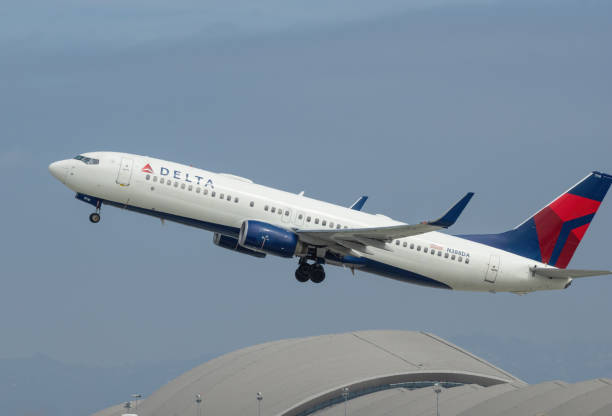Overview of the Incident
Delta Flight DL275, a Boeing 767-300ER operating on a trans-Pacific route, was diverted to Los Angeles International Airport (LAX) after the flight crew identified a technical irregularity. As a precautionary measure, the captain rerouted the aircraft to LAX, where it landed smoothly without incident. Emergency units were placed on standby in line with aviation safety protocols, emphasizing that passenger safety remains the airline’s top priority.
What Happened Onboard Delta Flight DL275 Diverted LAX
The flight, scheduled as a long-haul international service, encountered a technical warning during cruise. While the issue was not classified as critical, the crew opted for caution and diverted to Los Angeles.
The captain informed passengers that the diversion was purely a safety step, which caused brief tension inside the cabin. However, the calm professionalism of the flight crew reassured travelers. Emergency responders awaited the arrival at LAX, but the landing proceeded without complications.
Why Airlines Select Diversion Airports
When an in-flight issue arises, airlines carefully evaluate where to divert.
Proximity & Safety Infrastructure
LAX was chosen because of its extensive facilities, multiple long runways, and highly trained emergency teams. As one of the busiest hubs in the U.S., Los Angeles International Airport is well-equipped to handle diversions of wide-body jets like the Boeing 767.
Passenger Care & Logistics
Beyond technical resources, LAX also offers strong passenger support. Medical services, airline representatives, and ground transport options ensure that travelers receive assistance with rebooking, accommodations, and onward connections.
Passenger Experience During the Diversion
For those on board Delta Flight DL275, emotions ranged from nervousness to relief. Some travelers reported initial anxiety after the announcement, while others felt reassured by the transparency of the crew.
Conversations inside the cabin shifted to questions of safety, but as the aircraft descended toward Los Angeles, many found comfort in seeing the city lights and knowing emergency responders were prepared. Upon safe landing, relief spread through the cabin, with several passengers personally thanking the flight attendants and pilots.
How Delta Handles In-Flight Emergencies
Rigorous Training
Delta ensures its pilots and cabin crews undergo extensive emergency training. Pilots practice simulated scenarios, while flight attendants are drilled in medical events, equipment issues, and passenger assistance.
Communication Protocols
During unexpected events, clear communication is essential. Delta’s crew provided consistent updates, keeping travelers calm and informed. This approach helped reduce panic and built trust throughout the diversion process.
Ground Operations Support
Behind the scenes, Delta’s operations teams coordinated with LAX authorities, adjusted flight schedules, and prepared to assist passengers upon arrival. While diversions incur extra costs, safety always outweighs financial concerns.
Why Diversions Like This Occur
Aircraft diversions happen for several reasons, including:
- Technical warnings such as engine alerts or pressurization issues
- Passenger or crew medical emergencies
- Severe weather at the destination
- Security concerns or unruly behavior
In the case of Delta Flight DL275, the diversion was linked to a technical alert requiring extra caution. Aviation safety culture prioritizes conservative decisions to minimize any potential risk.
The Role of LAX in Global Aviation Safety
LAX is a critical hub for diversions, especially for trans-Pacific flights. Its infrastructure, advanced air traffic control, and specialized emergency teams make it an ideal landing point for international wide-body aircraft.
Aircraft in Focus: Boeing 767-300ER
Delta’s Boeing 767-300ER has a strong safety record and is designed for long-haul international routes. Despite thorough pre-flight checks, occasional alerts may still arise mid-journey—highlighting the importance of diversion procedures in modern aviation.
Operational & Passenger Impact of Diversions
Airline Costs
Diversions result in fuel costs, rebooking challenges, and schedule disruptions for the airline.
Passenger Challenges
Travelers may face delays, missed connections, or overnight stays. However, most acknowledge that such precautionary decisions are necessary to ensure safety.
Lessons From Delta Flight DL275 Diverted LAX
The safe outcome of this event reinforces how airlines rely on training, coordination, and communication to manage unexpected challenges. It also highlights that passenger safety always comes before convenience.
Aviation Safety & Passenger Confidence
While diversions can cause inconvenience, they underscore aviation’s safety-first culture. Air travel remains one of the safest forms of transportation, with every incident contributing to stronger safety standards.
Read more: Boeing 767
Conclusion: Delta Flight DL275 Diverted LAX Shows Aviation Safety in Action
Delta Flight DL275’s precautionary diversion to Los Angeles demonstrates the airline’s commitment to passenger protection. Though moments of uncertainty arose, the professional handling by the crew and the preparedness of LAX ensured a secure outcome.
This incident serves as a reminder that every flight is supported by highly trained professionals, strict safety procedures, and a global infrastructure designed to protect passengers at all times.
Read Also: 3381012544




